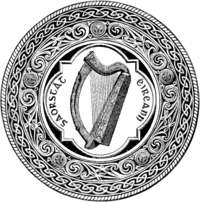*Image Credit: Wikimedia Commons Almost four years after the first battle in the Anglo-Irish War, those seeking an independent Irish Free State got what they wanted on December 6, 1922. Twelve months to the day of the Anglo-Irish Treaty, the British government granted the Irish control of the Emerald Isle. A week later, the six counties of Northern Ireland exercised their right to secede, leading to a decades-long struggle known as “the Troubles.” Irish nationalists had been in search of sovereignty for 25 years by the time of the Easter Rising of 1916. When the rebellion failed and its leaders were put on trial for treason, the movement folded itself into Sinn Fein, turning it into the political arm of the Volunteers — those willing to use force against the British. When Parliament attempted to force Irishmen to serve in the military in the wake of German victories during the spring of 1918, an ethnic group which already opposed the involvement of its young men in World War I grew louder with its discontent. Vast numbers of seats in the Irish government were won by Sinn Fein politicians that December, with the leadership deciding to bypass the Parliament of the United Kingdom in Westminster to form an Irish legislative body on January 21, 1919 in Dublin. Holding fast to the belief an “existing state of war, between Ireland and England,” the politicians voted to organize the IRA — something that had happened almost on its own already. (Four men without any connection to the meeting shot two British constables in Soloheadbeg with the intention of starting a war.) By April 1919, the Dail — the Irish-only parliament in Dublin — had yet to make an official declaration England was their enemy. For nearly two years, as violence spread throughout Ireland against British offices and administrators, there was no true political movement with respect to the Crown. Only the imposition of martial law in 1920 and a dramatic rise in the death toll during the first half of 1921 would yield that. On July 11, 1921, the two sides declared a cease-fire to negotiate a settlement. For six months, the British and Irish worked through the details in order to come to an agreement about the best course for those counties which wished to remain part of the British Empire (just 6 of 32) and the districts campaigning for an Irish Free State. With the signing of the Anglo-Irish Treaty on December 6th, the parties had come to a conclusion which would allow for an autonomous 32-county nation. Exactly a year to the day — December 6, 1922 — the Irish Free State took on the role of self-government. Just 24 hours later, the counties which comprise modern Northern Ireland appealed to the Crown for separation from the rest of the island. Though not truly independent, the 26 counties of the Free State would have its own army and police, a fact which led to a number of clashes between British-backed opposition and Irish nationalists well into 1923 as part of the Irish Civil War. With bitterness reigning on both sides of the conflict, the IRA took on the mantle of being a paramilitary organization, launching guerilla attacks on British interests in Ireland and high-ranking officials until disarming completely in February 2009. Also On This Day: 343 – Saint Nicholas, Bishop of Myra and inspiration for the Christmas icons Santa Claus and Father Christmas, dies 1704 – Sikh warriors choose to be martyred as Mughal warriors bear down on their mud fort at the Battle of Chamkaur 1768 – The Encyclopedia Britannica is published for the first time 1877 – Thomas Edison makes his famous recording of “Mary Had a Little Lamb” 1884 – Construction of the Washington Monument is completed You may also like : December 6 1768 – Encyclopædia Britannica is published for the first time
December 6 1922 – The Irish Free State Comes into Existence One Year After the Anglo-Irish Treaty
*Image Credit: Wikimedia Commons Almost four years after the first battle in the Anglo-Irish War, those seeking an independent Irish Free State got what they wanted on December 6, 1922.…
318
